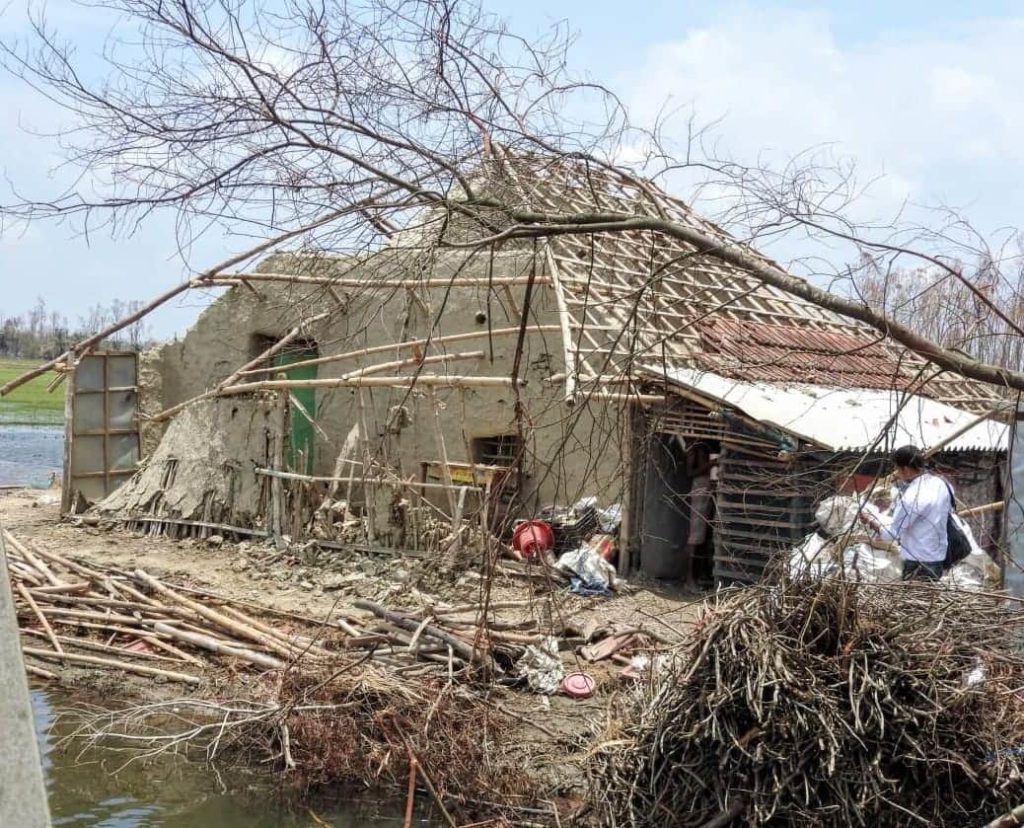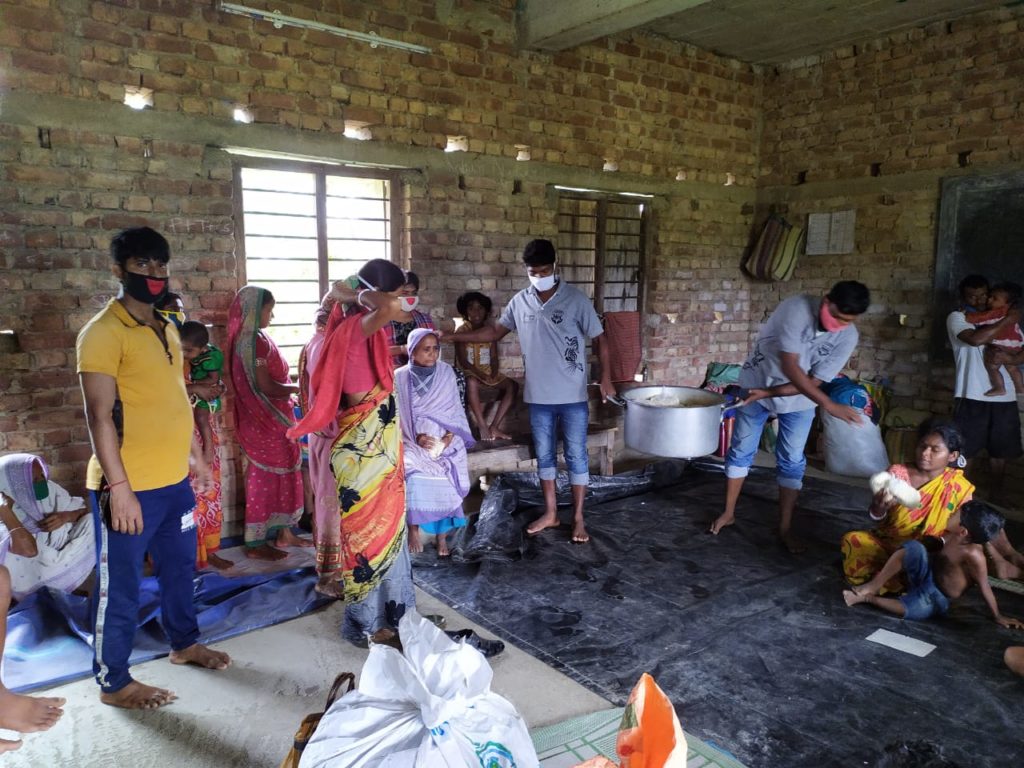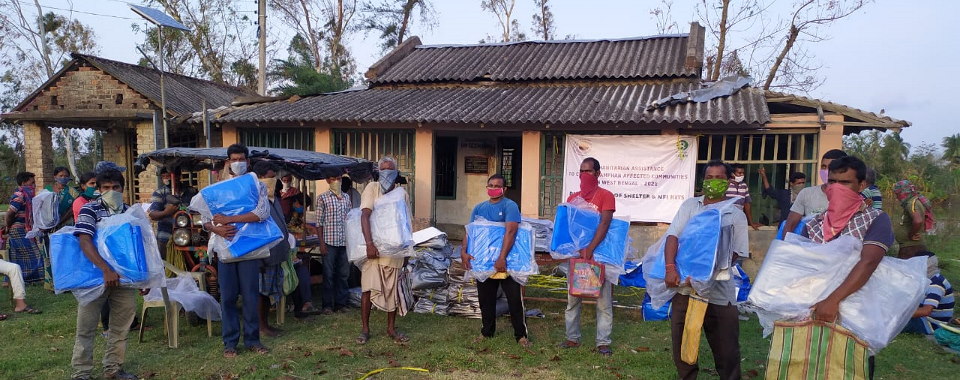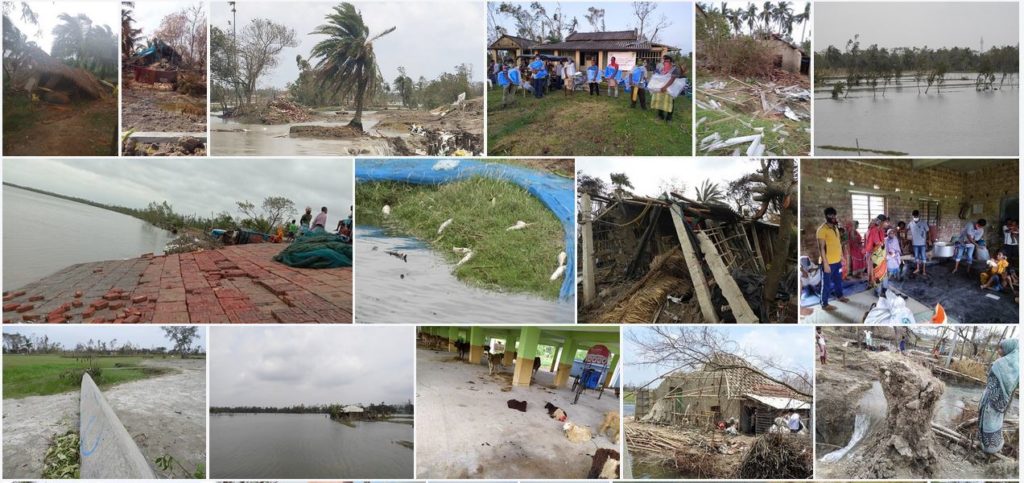by Upasona Ghosh, Shibaji Bose, Debdatta Chakraborty, TAPESTRY project
“We will build it again. We have done the same before and might have to do it many a time in future,” says Rakesh Mondal, a middle-aged resident of Kultoli block in the Indian Sundarbans, looking at his near-flattened house.
The house took a direct hit from cyclone Amphan, which lashed the island with a wind-speed of 185 km/hr on the early evening of 20 May. The Category 4 cyclone ravaged the Sundarbans, the world’s largest mangrove delta. This dissipated some of Amphan’s energy, shielding densely-populated cities like Kolkata from the storm, but the impact devastated millions of people who live in the delta, directly claiming at least 98 lives.
In the Sundarbans alone, Amphan killed hundreds of livestock, damaged a million houses, destroyed the produce of nearly half a million farmers, breached embankments spread over 160 km, and pushed water up to 15 km inland in parts of the Sundarbans. The morning after the storm, islanders awoke to the sight of uprooted trees, rows of damaged mud and concrete houses, ravaged fields and ponds with rotting leaves, uprooted trees and dead fish, flooded with seawater.

Now, was this something unexpected? It depends who you ask. For policy makers, academia and modellers, there is a significant body of evidence that suggests natural disasters in the delta are becoming more frequent, and that environmental change plays a role. There is also the experience of local self-government and community-based organizations, gained during the time of cyclone Bulbul in 2019 and Aila in 2009. This includes community knowledge of dos and don’ts, learned by living through numerous localized embankment breaches, inundation, land erosion and floods.
In a nutshell, in the last two decades, scientific research evidence, media stories, national and international agencies have provided evidence on the local impacts of global climate change on the life and livelihoods of the Sundarbans. Scientific studies and government reports are even available on the impacts of climate change on the remotest parts of the delta, like Ghoramara, an almost extinct island of the Sundarbans.
Photo gallery: Amphan and the Sundarbans
But what is happening with those bodies of evidence? Are they getting reflected in policy and planning? The answer is at least partly embedded within the complex political economy of policy making for the Sundarbans.
Some aspects of policy have definitely taken the problems on board – especially among disaster management, Disaster Risk Reduction (DRR) programmes and post-disaster relief work. The benefits of this are evident in the evacuation of more than 300,000 people during Amphan. In the immediate aftermath of the cyclone, realizing the magnitude of destruction, the State Government announced funds of Rs 625 billion to help affected people rebuild their lives, and a relief fund of Rs 100 billion has been promised by the national government.

National and international NGOs are not letting up on their own relief operations in Sundarbans. These efforts remind us of the huge relief and rebuilding work done by the same stakeholders when Aila struck Sundarbans in 2009. The government and agencies responded during Aila, providing funds to local CBOs/NGOs for significant sectors like livelihoods, health and agriculture. But the funds and the focus soon shifted, as most of the agencies had strict DRR response timelines. Local organizations also had to shift their focus on to other donor-driven programs for sustainability: relief and rehabilitation are always driven from the top down in the Sundarbans.
A decade later, history has repeated itself, but with larger impacts. Amphan came at a crucial time, when the Covid-19 pandemic was already affecting people’s life and livelihood in unprecedented ways. For the people of the Sundarbans grappling with cyclone Amphan, the lackadaisical and top-down planning and piecemeal interventions are nothing new. Only now, living with an uncertain and variable climate coupled with COVID, and the reality of frequent disasters, most of the islanders are unable to make even short- to medium-term decisions for their life and livelihood.
Reactions to the crisis have varied between the island and mainland parts of the Sundarbans, depending on people’s different levels of vulnerability – which is in turn affected by their socio-economic status, social position and the physical geography of the place where they live.
What can be done, and by whom? After Aila, the most popular coping strategy for islanders was migration, mainly among men who migrated seasonally for work. However, the Covid-19 lockdown now makes this kind of migration virtually impossible.
Adding to the woes, there has been a steady stream of migrant islanders who are now being forced to return to the delta from different parts of India. In this unprecedented scenario, people in the most affected regions are trying to survive on government and NGO relief packages, and waiting for the Covid-19 crisis to subside, so that they can go back in larger numbers in search of jobs.
Beyond the short term impacts of Amphan and Covid-19, scientific evidence suggests that this unique ecosystem needs special long-term planning to deal with environmental change and climate disruption. The region needs transformative changes, not merely incremental improvements or more infrastructure. To be sure, disaster response is an important part of a comprehensive response to frequent cyclones, but it is not enough alone to save the Sundarbans.
The need of the hour, more than any time before, is to realize and act on long-term adaptation planning, in which an already resilient community should actively participate. With one third of the Sundarbans being repeatedly devastated by disasters on a yearly basis, there perhaps is a need to incorporate a block-level plan for sustaining skill-based livelihoods and food security. Otherwise, we will again end up writing many scientific and popular pieces, until another cyclone ravages Sundarbans, with even more people suffering silently while coping under undesirable and socially unjust conditions.
Webinar: Transformations in and beyond Covid-19 in India and Bangladesh
An online discussion on Covid-19, cyclone Amphan and the possibilities of transformative change for people living in ‘marginal’ environments.
Tapestry project
This blog post is related to the TAPESTRY project. For more information, visit the project page.


Excellent ground level observation and suggestion for Sundarban. We would like to know more on skilled based alternate livelihood options. Waiting eagerly for next write up.